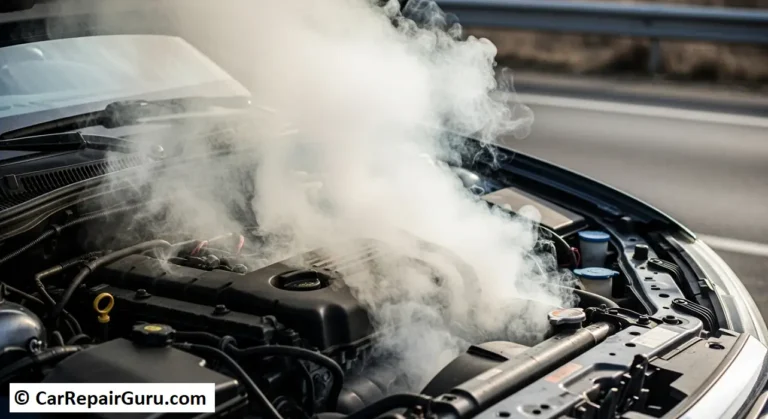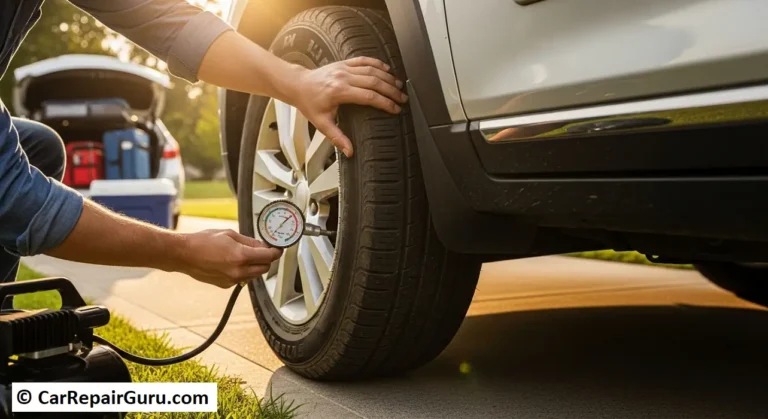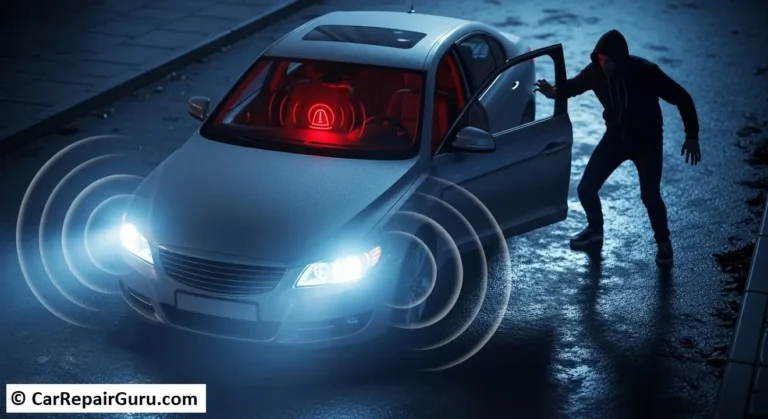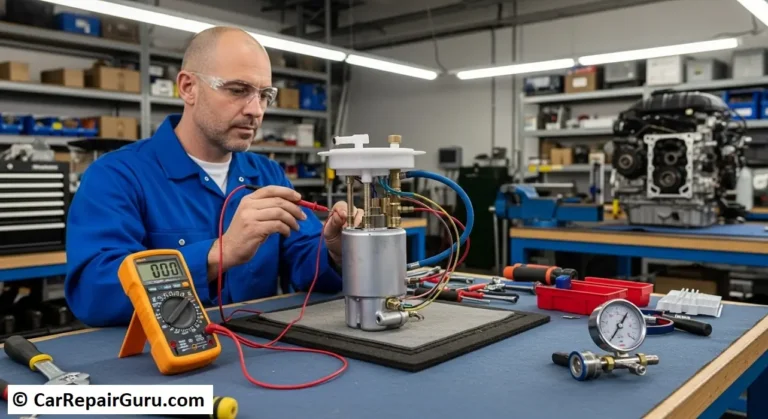
Waking up to an empty driveway where your car used to be is a gut-wrenching experience. It’s more than just losing a vehicle; it’s a loss of freedom, a financial nightmare, and a deeply personal violation. And unfortunately, it’s happening more often. According to the National Insurance Crime Bureau (NICB), vehicle thefts have surged in recent years, with a car being stolen approximately every 32 seconds in the United States.
But here’s the good news: you are not powerless. Most car thefts are crimes of opportunity, and by taking smart, proactive steps, you can make your vehicle a much harder target.
This is your complete guide to protecting your car from theft. We’ll cover everything from simple, no-cost habits to the best anti-theft devices on the market. Think of it as building layers of security around your investment. The more layers a thief has to get through, the more likely they are to give up and move on.
Does Your Car Make You a Target? Top Risk Factors for Vehicle Theft
Before we dive into solutions, it’s crucial to understand what makes a car attractive to a thief. Car theft prevention starts with knowing your own risk level. Is your car a walking bullseye?
1. Your Vehicle’s Make and Model
It’s a simple case of supply and demand. Thieves often target popular, common vehicles not to joyride, but to dismantle them at “chop shops” and sell the parts. Models like the Honda Accord, Honda Civic, and full-size Ford and Chevy pickups consistently top the list of most-stolen vehicles. Why? Because their parts are in high demand and are interchangeable across many model years. You can check the latest NICB “Hot Wheels” report to see if your car is a frequent target.
2. Location and Parking Habits
Where you park is one of the biggest factors in car security. Thieves thrive in darkness and isolation. Poorly lit streets, deserted public parking garages, large mall lots, and even your own quiet driveway can be prime hunting grounds. They are looking for places where they can work undisturbed for a few minutes.
3. The Age of Your Car (Old vs. New)
Both old and new cars are at risk, but for different reasons.
- Older Cars (Pre-2000s): These vehicles often lack modern anti-theft technology like factory-installed engine immobilizers, making them much easier to hot-wire and steal using traditional, low-tech methods.
- Newer Cars: While packed with security features, modern cars are vulnerable to sophisticated high-tech attacks. Thieves have found ways to exploit keyless entry and push-to-start systems, stealing a brand-new car without ever physically touching the key fob.
Understanding the Enemy – How Modern Car Thieves Operate
To effectively secure your vehicle, you have to think like a thief. Brute force is still in their toolbox, but today’s criminals are often tech-savvy and efficient. Here are their most common methods.
4. Relay Attacks (Keyless Entry Theft)
This is the scariest and most common high-tech method. It works like this: your key fob is constantly emitting a low-level signal. A thief stands near your front door with a relay amplifier (like a Wi-Fi signal booster) that captures that signal. The device then transmits it to a second accomplice standing next to your car with a receiver. Your car is fooled into thinking the key is right there, allowing the doors to be unlocked and the engine started with the push of a button. They can be gone in under 60 seconds.
5. OBD Port Hacking and Key Programming
Every car made since 1996 has an On-Board Diagnostics (OBD) port, usually located under the steering wheel. This is what your mechanic uses to diagnose issues. Thieves can break into your car, plug a special device into this port, and program a blank key fob to work with your vehicle in minutes.
6. The Classic Smash-and-Grab and Hot-Wiring
Never discount the old-school methods. A thief sees a laptop bag on your seat, smashes the window to grab it, and then realizes the car is an older model without an immobilizer. A few moments of work under the steering column, and they can drive it away.
7. Catalytic Converter and Parts Theft
Sometimes, the thief doesn’t want the whole car. Catalytic converters contain precious metals like platinum and rhodium, making them incredibly valuable on the black market. A skilled thief can slide under your car with a battery-powered reciprocating saw and cut one off in less than two minutes.
Part 1 – The Foundation – Simple, No-Cost Habits to Deter Thieves

The most powerful layer of car security is completely free. It’s about cultivating smart habits that make your car an unappealing, inconvenient target. Start with these today.
5. Always Lock Your Doors and Close Your Windows
This sounds obvious, but you’d be shocked at how many thefts occur because a door was left unlocked. A thief will almost always check the door handle first. If it’s locked, they may move on to an easier target. An open window is an open invitation.
6. Park in Secure, Well-Lit Areas
Thieves are like vampires—they hate the light. Whenever possible, park in a well-lit area with plenty of foot traffic. At home, a garage is your best option. If you must park on the street, choose a spot under a streetlight or near a busy intersection.
7. Never Leave Your Car Running and Unattended
Warming up your car in the winter or leaving it running for a “quick” run into the convenience store is a recipe for disaster. This is called a “puffer” theft, and it’s one of the easiest ways for a criminal to get a free car.
8. Hide Your Valuables (Or Take Them with You)
Don’t tempt them. A visible phone, wallet, GPS unit, or even loose change can be enough to entice a break-in. Once a thief has broken a window, they are one step closer to trying to steal the entire vehicle. Put everything out of sight in the trunk before you arrive at your destination.
9. Never Leave Your Keys or Fob in the Car
Again, this seems like a no-brainer. But this includes that “spare” key you hide in the glove compartment or under the seat. Thieves know all the hiding spots. Your car key is the master key to your investment; treat it like gold.
Part 2 – Visible & Physical Deterrents – Making Your Car a Hard Target
The next layer involves making your car look like too much work. These physical anti-theft devices are powerful visual deterrents that scream “this car is protected, move along.”
10. Use a Steering Wheel Lock
This is a classic for a reason. A big, brightly colored bar like The Club locked across the steering wheel is instantly recognizable. A thief knows they can’t just break in and drive away. They’d have to spend noisy, time-consuming minutes trying to cut through hardened steel, which is a risk most aren’t willing to take.
11. Install a Brake or Pedal Lock
Less common but highly effective, these devices lock onto your brake or clutch pedal, rendering it unusable. Even if a thief could start the car, they wouldn’t be able to put it in gear or stop it.
12. Consider Tire or Wheel Locks
While primarily used to prevent the theft of expensive custom rims, a “boot” style wheel lock (like the ones used by parking enforcement) makes it impossible to drive the car away. This is an excellent option for long-term parking or if you have a highly desirable vehicle.
13. Get Your VIN Etched on Your Windows
Your Vehicle Identification Number (VIN) is a unique serial number. You can have it professionally and permanently etched into all of your car’s windows. This is a subtle but powerful deterrent. Why? Because a thief who wants to sell the car or its parts would have to replace all the glass, a costly and time-consuming process that slashes their profit.
Part 3 – Advanced Security – Electronic and Tech-Based Solutions
Now we move to the high-tech layer. These electronic solutions are designed to stop a thief in their tracks or help you recover your vehicle if the worst happens.
14. Install an Aftermarket Car Alarm System
While most modern cars come with a factory alarm, they are often basic. A quality aftermarket car alarm system can offer greater sensitivity, a much louder siren, and advanced features like two-way pagers that alert your key fob if the alarm is triggered.
15. Use an Engine Immobilizer
An engine immobilizer is an electronic security device that prevents the engine from running unless the correct key or key fob is present. Most cars manufactured in the last 20 years have one. If you have an older or classic car, installing an aftermarket immobilizer is one of the single most effective ways to prevent car theft.
16. Invest in a GPS Tracker
This is your ultimate safety net. If a thief manages to bypass all your other security layers and drive away, a hidden GPS tracker for your car is your best chance of recovery. These devices use GPS to transmit the vehicle’s real-time location to an app on your phone. You can give this information directly to the police, dramatically increasing the odds of getting your car back, often within hours.
17. Install a Kill Switch
A kill switch is a hidden switch that disrupts the flow of electricity to a critical component, like the fuel pump or ignition system. Unless a thief knows where you’ve hidden the switch and how to disable it, the car simply will not start, no matter what they try. It’s an inexpensive but brilliant way to foil even the most determined criminals.
Part 4 – Fighting the Latest Threats with Specific Countermeasures
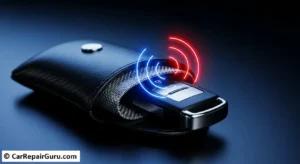
As thieves evolve, so must our defenses. Here’s how to counter their most popular modern tactics.
Protect Against Keyless Entry Theft (Relay Attacks)
Remember the relay attack we talked about? The solution is surprisingly simple. When you are at home, store your key fobs in a Faraday pouch or box. These containers are lined with a special material that blocks all electromagnetic signals. Your key fob’s signal can’t get out, so there’s nothing for the thief’s amplifier to pick up. It’s a cheap and incredibly effective fix for a high-tech problem.
Prevent Catalytic Converter Theft
Because they are so easy to access on many vehicles (especially trucks and SUVs), you need a specific defense. The best solution is to have a mechanic install a catalytic converter shield or cage. These are plates of hardened metal that physically block access to the converter, making it nearly impossible for a thief to cut it off quickly.
What to Do If Your Car is Stolen – A Step-by-Step Action Plan
Even with the best precautions, theft can still happen. If you find yourself in this situation, stay calm and act quickly.
- Call the Police Immediately: The sooner you file a report, the sooner law enforcement can be on the lookout. You will need your car’s make, model, year, color, license plate number, and VIN.
- Activate Your GPS Tracker: If you have one, open the app and give the police the vehicle’s real-time location. Do not attempt to recover the vehicle yourself.
- Contact Your Insurance Company: Call your insurance agent to report the theft and begin the claims process.
- Report to the DMV: Inform your local Department of Motor Vehicles that your car has been stolen. This helps protect you from any liability if the vehicle is used in a crime.
A Layered Approach is the Best Defense
Protecting your car from theft isn’t about finding one single, foolproof solution. It’s about creating a multi-layered defense system that makes your vehicle as difficult and unappealing to steal as possible.
Start with the free, simple habits. Add a strong visual deterrent like a steering wheel lock. And for the ultimate protection and peace of mind, consider a high-tech solution like a GPS tracker or a kill switch.
Don’t wait until it’s too late. Take a look at your car and your daily habits today. By implementing even one or two new tips from this guide, you are taking a massive step toward keeping your vehicle safe, secure, and right where you left it.
Frequently Asked Questions (FAQ)
What are the most stolen cars in the US?
Typically, the most popular and common cars are the most stolen for their parts. Models like the Honda Civic/Accord, Ford F-150, and Chevrolet Silverado are consistently at the top of the list. Check the NICB’s annual “Hot Wheels” report for the most up-to-date data.
Do steering wheel locks actually work?
Yes. While a determined thief can eventually cut through one, they are primarily effective as a powerful visual deterrent. A thief is looking for a fast, easy target. Seeing a steering wheel lock often convinces them to move to the next car.
How can I stop my key fob from being scanned?
The most effective method is to store your keys in a Faraday pouch or box when you’re at home. This blocks the fob’s signal, making relay attacks impossible.
Is a GPS tracker worth the cost?
Absolutely. A GPS tracker is one of the few devices that can help you after a theft has already occurred. Given the high cost of a vehicle and the increased chances of recovery, it’s a very worthwhile investment for peace of mind.
